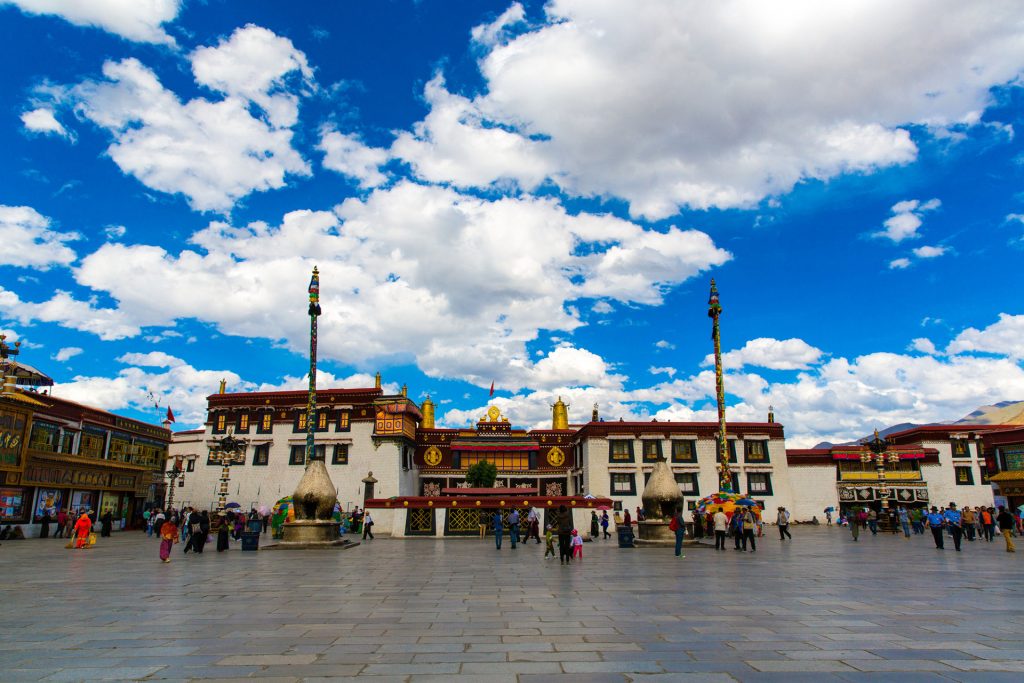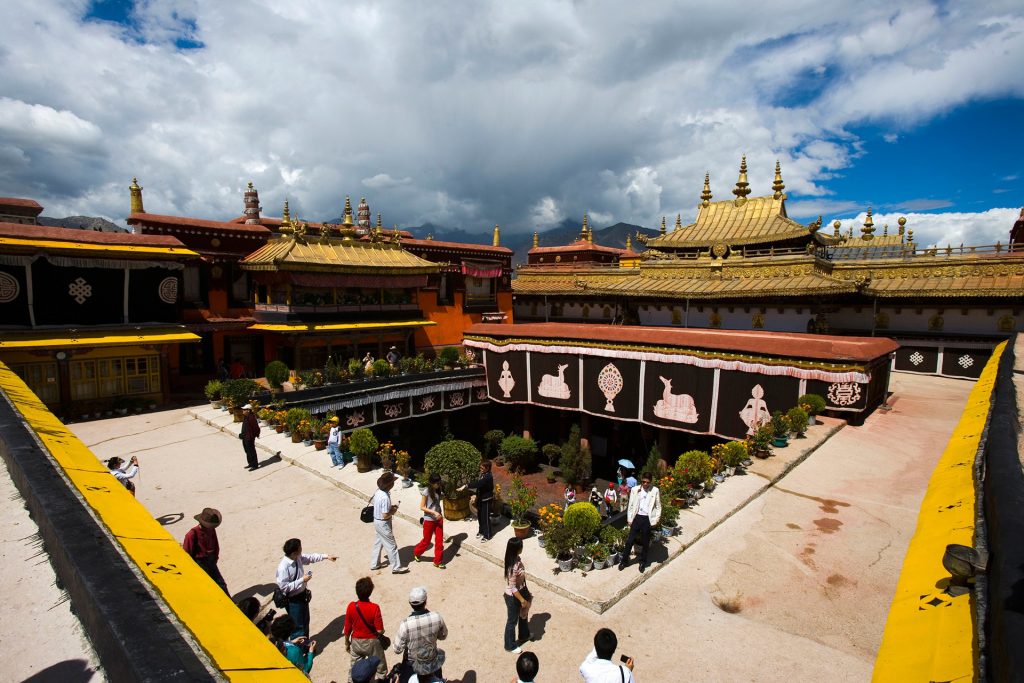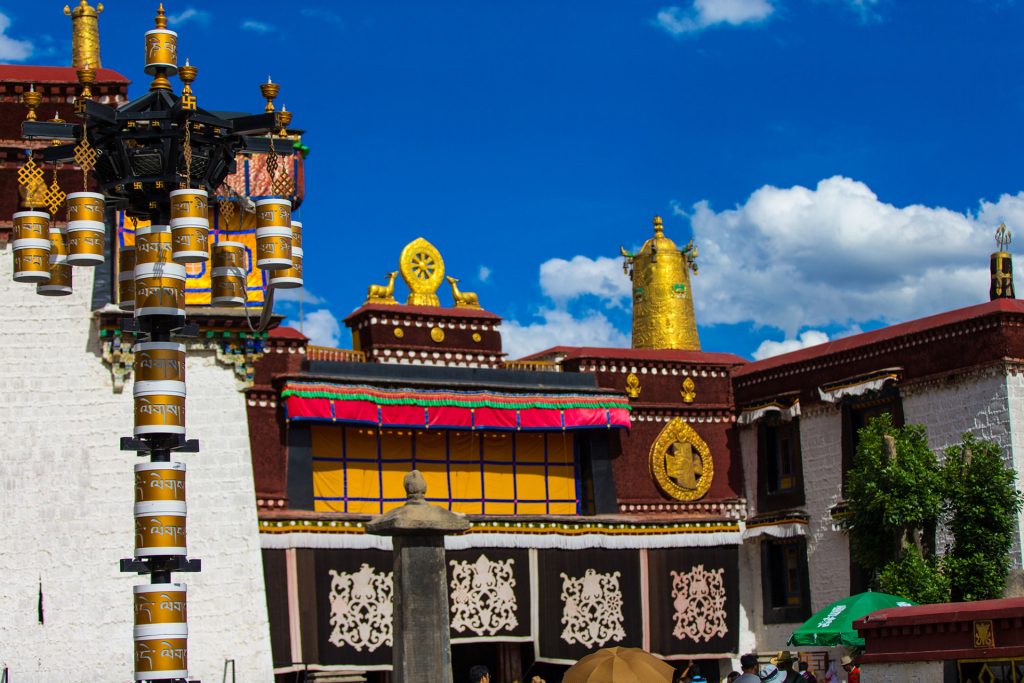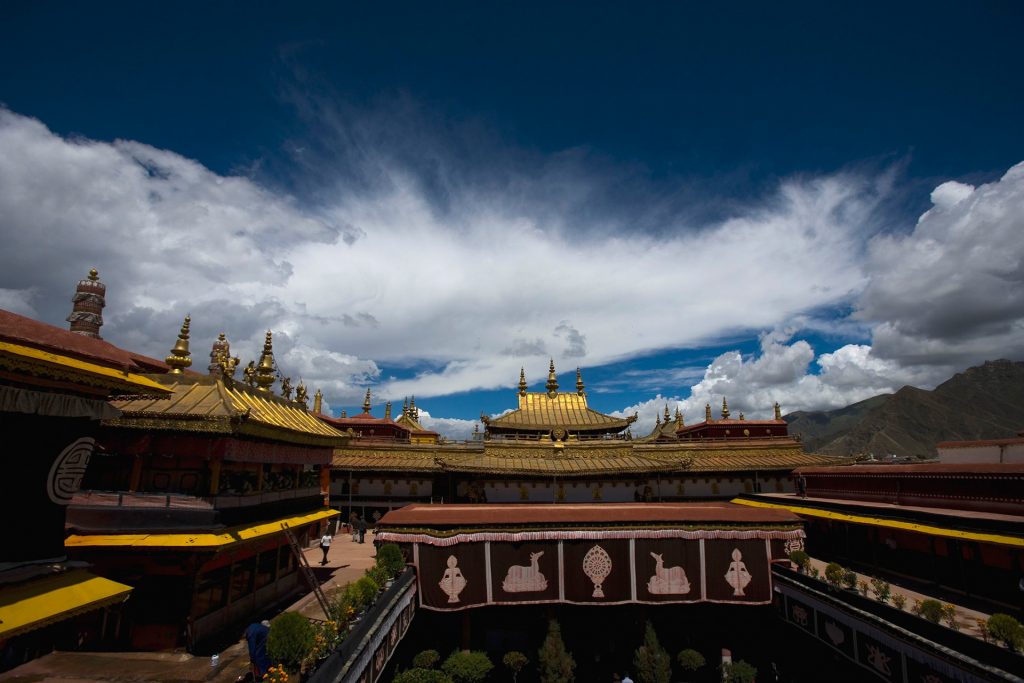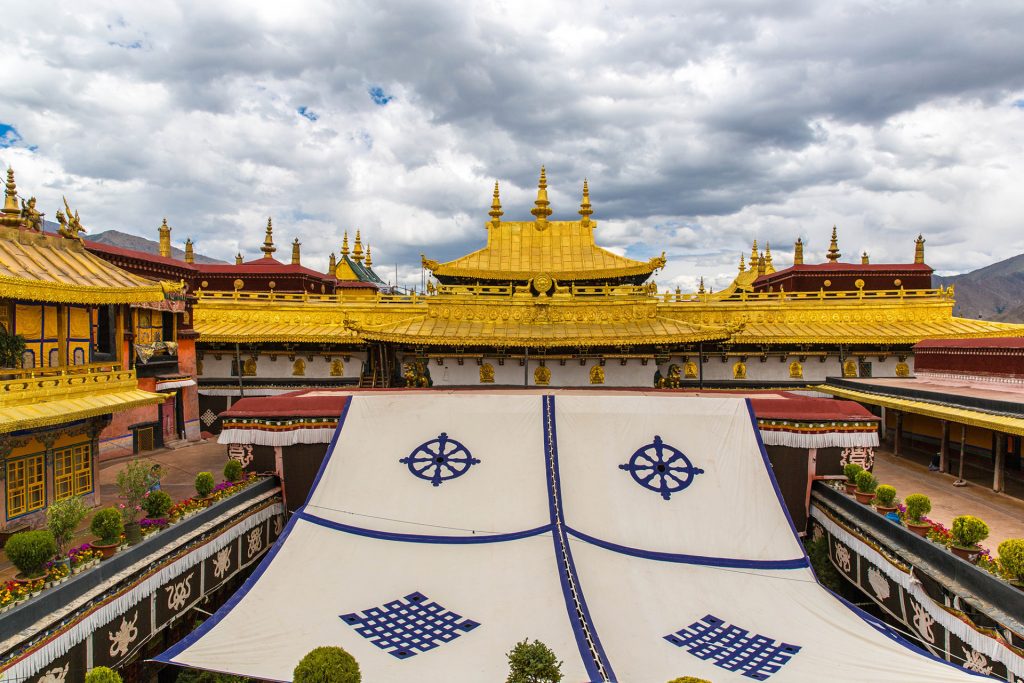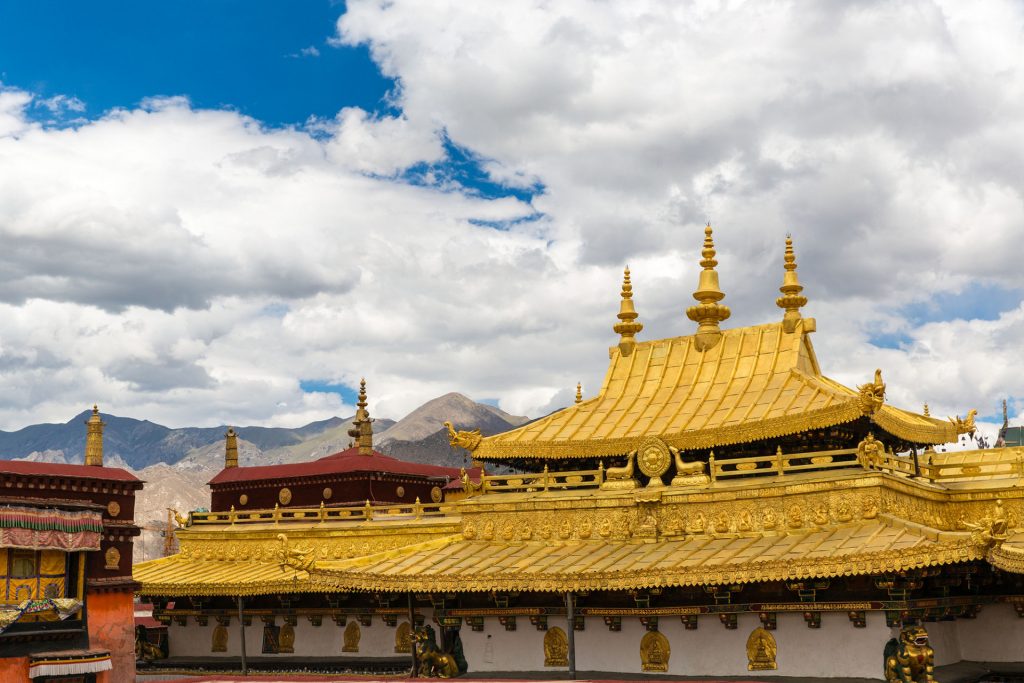Jokhang Temple is the spiritual center of Tibet the holiest destination for all Tibetan Buddhist pilgrims. Through night and day, there are lots of pilgrims kowtowing in front of Jokhang Temple. Jokhang means ‘House of Buddha’. Located in the center of old Lhasa city, Jokhang Monastery is the prime seat of the Gelugpa (Yellow) Branch of Tibetan Buddhism. It was originally built in 647 AD.
What to see
Jokhang Temple has 4 floors, and the whole building is in classic Han nationality style of goldentop, corbel bracket. Watchtower, carved roof beam is in Tibetan style, under the second and third floor’s eaves of main hall there was lined 103 wooden carving beasts and sphinx, and inside the temple there is nearly thousands kilometers long Tibetan fresco “princess Wencheng come to Tibet ” and “the Jokhang Temple Construction “.
【The Maitreya Hall】
The main figure of this Buddha hall is a small and delicate Maitreya Buddha, every year during the Monlam this figure of Buddha will need to be carried to have ritual parade along Barkhor Street. A Bodhisattva Manjusri and Avalokitesvara placed on both side of this statue of Buddha, and beside these two bodhisattvas’ figures is a statue of Tara figure in lotus position respectively. In addition, the four guardian deities close to the wall with anger form are to protect the Buddha hall. On the right side of door is vaisravana (one of the heavenly kings in Buddhism), the left is the god of wealth Gabarra. Upon altar is a figure of lama Jiewabumu, he had built the weir dam in Lhasa to prevent from attack by flooding. When enter the door if you look at the lower left corner of the temple, you will see a small rocky mountain goat. This is the legendary holy goat that carried soil to fill Wotang Lake.
【Avalokitesvara Hall】
The main Buddha figure is small Avalokitesvara figure riding on a lion (first figure from the left) instead of the great Amitabha Buddha, and the rest of the five Buddha figures are different embodiment of Avalokitesvara.
【Grandparent and Grandchildren Three Princes of Dharma Hall】
The main Buddha figure in this hall is Tibetan king Sontzen Gampo, Tibetan king Trisong Detsenon is on the left and Tibetan king Ralpacan is on the right. The three Tibetan kings ruling period was Tubo (Tibet regime in ancient China) heyday, under their strong support so that Buddhism could introduce into Tibet regime in ancient China, and was developed and prosperous. They were three princes of Dharma in the history of Tibet, traditionally they were called “Grandparent and Grandchildren Three Princes of Dharma”.
【Tara Hall】
Tara Hall consecrated Tara. In the middle of the hall is Tara figure and behind the figure in the glass-frame cabinet is main embodiment of “twenty one Tara figure”. On the right of Niche there are six statues of Buddha, the former three are known as “three division kings” of a group of figure of Buddha, that is Shantarakshita Khenpo, padmasambhava and prince of Dharma Trisong Deutsen. The other three are “three figures of teacher and pupils “, namely the master Tsongkhapa and his two disciples, master Kezhujie and Jiacaojie.
【Monument Commemorating Tang Dynasty’s Aligning with Tibet】
Into the small square in front of the Jokhang Temple, you can see the outline of the Jokhang Temple. The first thing that comes to people’s sight is two pieces of stone tablets surrounded by the circle of walls. A piece of the south is the famous Monument Commemorating Tang Dynasty’s Aligning with Tibet, 3.42 meters high, 0.82 meter wide, 0.35 meter thick, established in Tang dynasty Changqing period third year (AD 823) and carved in both Mandarin and Tibetan.
The 9th century, Tang government and Tibet achieved reconciliation in an attempt to “not be each other’s enemy anymore”, “don’t involve in war”, “making people living in country at peace”. Then btsan-po (Tibetan ruler) Ralpacan in order to show the sincerity of friendship between two countries, he set up the monument in front of the Jokhang Temple, the inscriptions wrote earnestly, and it has weathered now, but most of the inscriptions is still legible. Beside the tablet is a willow tree, reportedly grew by princess Wencheng, called as the princess willow by local people.
【Jokhang Temple Goldentop】
Underlying the ticket office, there is stair can directly lead to the second and third floors of the platform. On the platform overlooking, people can see Potala Palace is glorious under the bright light of the sun. From here, people can also overlook the stream of people walk in the Jokhang Temple square, and can view the vitality of Tibetan in Barkhor Street. There is tea bar in summer, you can rest here.
Legend
Tibetan people have a saying that “There is Jokhang Temple first and then Lhasa city established”, the Jokhang Temple in Lhasa has the center position, which is not only a geographical position, is also embedded in social life.
【First Legend】
It is said that Jokhang Temple site was originally a lake, Sontzen Gampo promised to Princess Bhrikuti in the lake that he would built a temple in the place where the ring fell, unexpectedly the ring fell into the lake and at once the lake was spread light network, light network showed a grade nine white pagoda. Hence, a project started with thousands of white goats carried soil to build the temple.
【Second Legend】
Two princesses brought precious Sakyamuni Buddha respectively. As the most valuable dowry, Nepal princess of Buddha brought life-size Sakyamuni Buddha of the age of eight; Princess Cencheng from China mainland Changan brought a 12-year-old life-size Sakyamuni Buddha. Tibetans recognized these two Buddhas were the first two Buddhas entered the snowy plateau, and then in order to propitiate such sacred Buddha, Sontzen Gampo began to build the earliest Buddhist buildings in the history of Tibetan Buddhism, that is the Jokhang Temple and Ramoche Temple.
【Third Legend】
Legend has that during construction of Jokhang Temple, it suffered flooding a few times. Princess Wencheng explained that the whole of the Qinghai-Tibet plateau was a supine raksasi. The demon represented “人” shape, the head toward the east, the legs toward the west with lying arms, and the Jokhang Temple lake was originally raksasi’s heart, the lake is her blood. So the princess Wencheng said the lake must be filled up and built the temple. Then princess Wencheng also recommended a dozen of other small monasteries in remote areas, suppressed the limbs and joints of raksasi, and to build the 13 monasteries.
According to the selected location by princess Wencheng, in order to build a temple first was to fill in the lake. At that time the transport was dependent on goats carrying bags of sand and soil, so filled the lakes, which laid a foundation to the Jokhang Temple. In fact, the word of Lhasa is from the Jokhang Temple. At first, Lhasa didn’t name LASA, ancient book wrote it RASA, RA is goat, SA is land, meaning the place built by goat. Later because of building this sacred Buddha hall to propitiate the Buddha and there are Buddhist scriptures, pagodas, and all sides of believers pilgrimage here, everyone think this place is the Buddha place, so renamed Lhasa, LA is the meaning of the Buddha in the Tibetan language, SA means ground.
Travel Guide of Jokhang Temple
【Best time to travel Jokhang Temple】 It is suitable to visit Jokhang Temple from March to October.
【How to get to Jokhang Temple】As the Temple is in the downtown centre you can just walk there; or take bus 7, 8, 20, 22, 23, 25, 28 or 29 to Chongsaikang bus stop and walk south for 5 minutes to get there.
| Entrance Fee | CNY 85 |
|---|---|
| Opening Hours | 7:00 – 17:30, while from 7:00 to 11:30, it’s mainly open for pilgrims. |
| Recommended Time for a Visit | 2h |

